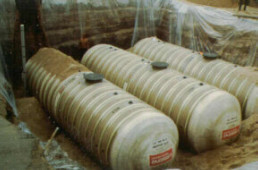 |
No longer deferred
The 1988 UST regulations deferred several types of USTs from regulations. Under the 2015 amendments, three types of tanks were removed from the referral list and must comply with the 2015 UST regulations.
USTs for emergency power generators.
The new UST amendments removes the deferral for USTs solely to store fuel for emergency power generators, and requires release detection for these tanks. These UST systems have been subject to all other parts of the UST requirements since 1988. They were deferred from release detection in 1988 because the EPA said that technology was not available at the time to monitor remote sites. The technology is now available, and owners/operators of existing systems must be in compliance with release detection requirements by October 2018. Systems installed after October 2015 must meet compliance requirements when the tank is installed.
With the newly released 2015 federal UST regulations, there are additional reporting and compatibility requirements for storing regulated substances blended with greater than 10 percent ethanol or greater than 20 percent biodiesel in UST systems. Learn more by attending this webinar on Tuesday, September 24.
Airport hydrant systems and field-constructed tanks
The new UST amendments remove the deferral for airport hydrant systems (AHSs) and field-constructed tanks (FCTs). These systems are subject to most of the other UST requirements but the recent amendments modify some of the requirements, most notably those in connection with release detection for FCTs. Owners and operators of these systems may use alternative release detection options, such as:
- Shop-fabricated tanks and FCTs with less than or equal to a 50,000 gallon (gal) capacity must comply with the release detection requirements applicable to all USTs.
- FCTs with storage capacity greater than 50,000 gal must comply with the release detection requirements applicable to all USTs, or do one of the following:
- Conduct annual tank tightness tests that can detect a 0.5 gallon-per-hour leak rate;
- Use an automatic tank gauging system to perform a release detection test once every 30 days and conduct a tank tightness test at least once either every 2 or 3 years;
- Perform vapor monitoring for a tracer compound capable of detecting a 0.1 gallon-per-hour leak rate at least once every 2 years; or
- Perform inventory control at least every 30 days according to a Department of Defense (DoD) directive 4140.25 (having to do with managing petroleum stocks) and either perform a tank tightness test once every 2 years or perform vapor monitoring or groundwater monitoring every 30 days.
- FCTs with greater than 50,000 gal storage capacity also have release detection options for piping. They must select one of the following options for piping:
- Monitor piping using the the release detection methods applicable to all USTs (piping that uses groundwater and vapor monitoring must combine those methods with the DoD directive 4140.25 once every 30 days).
- Perform semiannual or annual line tightness test at or above operating pressure.
- Perform vapor monitoring for a tracer compound capable of detecting a 0.1 gal-per-hour leak rate at least once every 2 years.
- Perform inventory control at least every 30 days according to the DoD directive 4140.25, and either perform a tank tightness test once every 2 years or perform vapor monitoring or groundwater monitoring every 30 days.
Ethanol and Biodiesel in Your ASTs and USTs: How to Prevent Corrosion and Achieve Compliance
Learn how to properly store alternative fuels in both aboveground and underground storage tanks while maintaining compliance with regulations that apply to your facility. Register today!
Hydrant pits and hydrant piping vaults are subject to the new periodic walkthrough inspection requirement. The amendments partially exclude aboveground tanks associated with AHSs and FCTs. These systems were deferred in 1988 because, the Agency said, there was not sufficient information and technology was not readily available for them. The 2015 amendments add a new subpart K at 40 CFR 280 for AHSs and FCTs.
